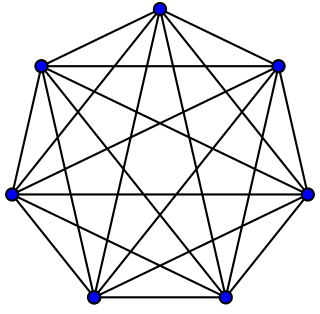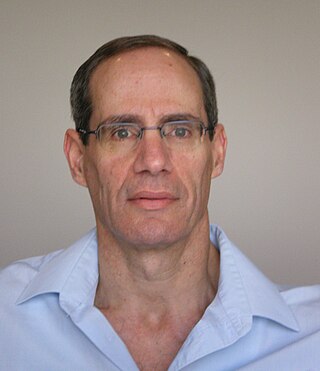Related Research Articles

In the mathematical field of graph theory, a complete graph is a simple undirected graph in which every pair of distinct vertices is connected by a unique edge. A complete digraph is a directed graph in which every pair of distinct vertices is connected by a pair of unique edges.

Fan-Rong King Chung Graham, known professionally as Fan Chung, is an American mathematician who works mainly in the areas of spectral graph theory, extremal graph theory and random graphs, in particular in generalizing the Erdős–Rényi model for graphs with general degree distribution.

Extremal graph theory is a branch of combinatorics, itself an area of mathematics, that lies at the intersection of extremal combinatorics and graph theory. In essence, extremal graph theory studies how global properties of a graph influence local substructure. Results in extremal graph theory deal with quantitative connections between various graph properties, both global and local, and problems in extremal graph theory can often be formulated as optimization problems: how big or small a parameter of a graph can be, given some constraints that the graph has to satisfy? A graph that is an optimal solution to such an optimization problem is called an extremal graph, and extremal graphs are important objects of study in extremal graph theory.

Béla Bollobás FRS is a Hungarian-born British mathematician who has worked in various areas of mathematics, including functional analysis, combinatorics, graph theory, and percolation. He was strongly influenced by Paul Erdős since the age of 14.

In graph theory, the Erdős–Faber–Lovász conjecture is a problem about graph coloring, named after Paul Erdős, Vance Faber, and László Lovász, who formulated it in 1972. It says:
The Fulkerson Prize for outstanding papers in the area of discrete mathematics is sponsored jointly by the Mathematical Optimization Society (MOS) and the American Mathematical Society (AMS). Up to three awards of $1,500 each are presented at each (triennial) International Symposium of the MOS. Originally, the prizes were paid out of a memorial fund administered by the AMS that was established by friends of the late Delbert Ray Fulkerson to encourage mathematical excellence in the fields of research exemplified by his work. The prizes are now funded by an endowment administered by MPS.
Joel Spencer is an American mathematician. He is a combinatorialist who has worked on probabilistic methods in combinatorics and on Ramsey theory. He received his doctorate from Harvard University in 1970, under the supervision of Andrew Gleason. He is currently a professor at the Courant Institute of Mathematical Sciences of New York University. Spencer's work was heavily influenced by Paul Erdős, with whom he coauthored many papers.

Noga Alon is an Israeli mathematician and a professor of mathematics at Princeton University noted for his contributions to combinatorics and theoretical computer science, having authored hundreds of papers.

Václav (Vašek) Chvátal is a Professor Emeritus in the Department of Computer Science and Software Engineering at Concordia University in Montreal, Quebec, Canada, and a visiting professor at Charles University in Prague. He has published extensively on topics in graph theory, combinatorics, and combinatorial optimization.
Van H. Vu is a Vietnamese mathematician, Percey F. Smith Professor of Mathematics at Yale University.

In graph theory, a branch of mathematics, a Hamiltonian decomposition of a given graph is a partition of the edges of the graph into Hamiltonian cycles. Hamiltonian decompositions have been studied both for undirected graphs and for directed graphs. In the undirected case a Hamiltonian decomposition can also be described as a 2-factorization of the graph such that each factor is connected.

Sumner's conjecture states that every orientation of every -vertex tree is a subgraph of every -vertex tournament. David Sumner, a graph theorist at the University of South Carolina, conjectured in 1971 that tournaments are universal graphs for polytrees. The conjecture was proven for all large by Daniela Kühn, Richard Mycroft, and Deryk Osthus.
Vojtěch Rödl is a Czech American mathematician, Samuel Candler Dobbs Professor at Emory University. He is noted for his contributions mainly to combinatorics having authored hundreds of research papers.
Miklós Simonovits (4 September 1943 in Budapest) is a Hungarian mathematician who currently works at the Rényi Institute of Mathematics in Budapest and is a member of the Hungarian Academy of Sciences. He is on the advisory board of the journal Combinatorica. He is best known for his work in extremal graph theory and was awarded Széchenyi Prize in 2014. Among other things, he discovered the method of progressive induction which he used to describe graphs which do not contain a predetermined graph and the number of edges is close to maximal. With Lovász, he gave a randomized algorithm using O(n7 log2n) separation calls to approximate the volume of a convex body within a fixed relative error.
The European Prize in Combinatorics is a prize for research in combinatorics, a mathematical discipline, which is awarded biennially at Eurocomb, the European conference on combinatorics, graph theory, and applications. The prize was first awarded at Eurocomb 2003 in Prague. Recipients must not be older than 35. The most recent prize was awarded at Eurocomb 2023 in Prague.
Daniela Kühn is a German mathematician and the Mason Professor in Mathematics at the University of Birmingham in Birmingham, England. She is known for her research in combinatorics, and particularly in extremal combinatorics and graph theory.
Robert (Rob) Morris is a mathematician who works in combinatorics, probability, graph theory and Ramsey theory. He is a researcher at IMPA.
Wojciech Samotij is a Polish mathematician who works in combinatorics, additive number theory, Ramsey theory and graph theory.
József Balogh is a Hungarian-American mathematician, specializing in graph theory and combinatorics.
References
- ↑ "Professor Deryk Osthus". Birmingham University. Retrieved 7 August 2014.
- ↑ "Deryk Osthus: Short CV". Birmingham University. Retrieved 9 August 2014.
- ↑ "Awards" (PDF), European Mathematical Society Newsletter, 50: 24, December 2003
- ↑ "LMS Prizes 2014". London Mathematical Society. Retrieved 7 August 2014.